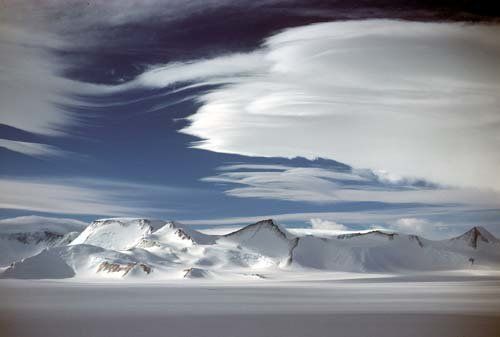In the static, lifeless landscape of the Transantarctic Mountains, the wind is the only animate force. It is movement and sound, alternately relentless and fickle. When it stops and the sun beams down from a cloudless sky, you can strip to bare skin and immediately feel the warmth. But let one puff of breeze disturb the thin layer of radiant air and shivers will well up. When the wind picks up, it buffets the parka and bites at fingertips, ear lobes, and nose. In its full fury the wind has flattened tents and thrown men from the decks of ships. At these times it is an awesome, fearsome force.
Winds in Antarctica are of two basic types. Cyclonic storms carrying moist, warm air spiral in from middle latitudes, bombarding the perimeter of the continent and sometimes dropping snow, but dissipating as they push toward the interior. Katabatic winds form over the ice cap where air is cooled by the ice, becomes denser, and pours down slope under the force of gravity. Barring their disturbance by a storm, these winds are a stable feature, and typically funnel into the outlet glaciers that cross the Transantarctic Mountains.
During the 1980-1981 field season, I was camped adjacent to the La Gorce Mountains a few miles from our put-in site on Robison Glacier. For the better part of the two weeks we spent at that camp, frigid, katabatic winds poured over us from the polar plateau to the southeast. With wind speeds generally around ten to fifteen knots and temperatures about minus 10° F, our days mapping the outcrops in the surrounding area were seldom comfortable, especially along ridgelines where the wind compressed and accelerated.
The La Gorce Mountains, perched at the edge of the polar plateau, are a first obstruction to katabatic winds that originate deep in the interior of the East Antarctic Ice Sheet. The flat top of these mountains slips smoothly from beneath the ice sheet and rises to the northwest to a dramatic escarpment that drops steeply more than three thousand feet and splays into two major ridge systems. When the katabatic winds meet the southeast or back side of the La Gorce Mountains, they split into three streams: two follow the descending glaciers on either side of the mountains, and a central stream shoots across the flat summit and plunges off the lip of the escarpment.
From our camp on the glacier we looked up to the escarpment. On days when the wind was light and there was only a trickle of granular, blowing snow around base camp, we could see a churning plume of wind and snow plummeting from the escarpment lip high above. We would watch it and imagine that somewhere back from the edge beyond where we could see there was a valve that tapped the source of all winds, screaming as it released its jetted fury.
During one three-day period, the wind speed rose to forty knots around camp, and we were forced to hunker in our tents, enveloped in blowing snow. It is during storms like these that I have learned to love the Scott tents. When planted properly, these four-sided pyramids will bear the fiercest gale, their double walls flapping loudly as they keep out the force of the wind. During this storm, tumultuous clouds ripped through the scene, opening periodically to reveal the escarpment lip beyond the adjacent ridge.
A storm such as this can move in quickly, so one has always to be cautious if working far from camp, and watch that the weather doesn't turn. To be caught out can truly be a matter of life and death. But back at camp with the warmth of the cookstove at hand, you can feel secure and even cozy. Then it is good to go out into the blast, not to confront the wind but to feel its pressure, to lean the body into it, to find the angle of balance, to sense the vagaries in the flow, to feel the cold, to listen to the voices wheezing and whistling around every obstacle in camp -- tents, boxes, bamboo poles.
Out beyond the noise of camp, you hear only the soft shoosh of blowing snow streaming through the sastrugi. You look up to a blue sky and down into the miasma of snow and wind at ground level, opaque beyond one hundred yards. You are walking at the dynamic interface of atmosphere and solid earth; wind pants flap, and you squint with one eye peering down the tunnel of your hood, balancing between the cross gust and the pitch of your stride. Nose drips and fingers begin to ache from the cold. The wind is right there with you. Slip on through its stream.
